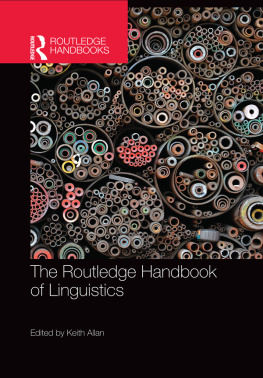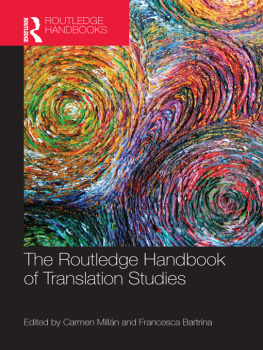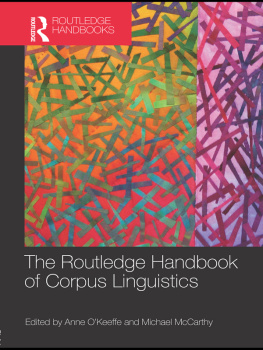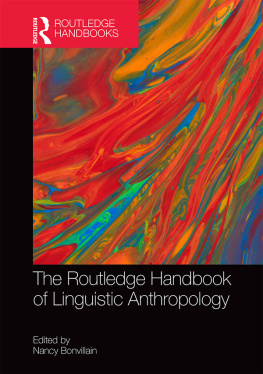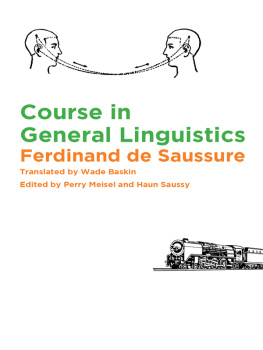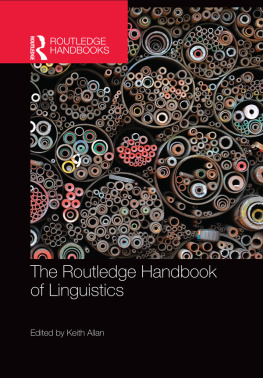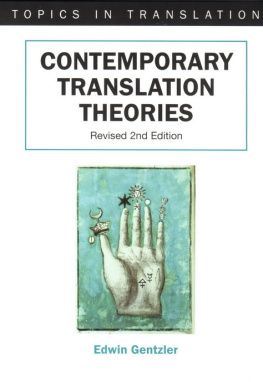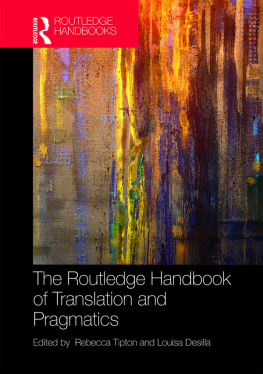Malmkjær - The Routledge handbook of translation studies and linguistics
Here you can read online Malmkjær - The Routledge handbook of translation studies and linguistics full text of the book (entire story) in english for free. Download pdf and epub, get meaning, cover and reviews about this ebook. City: London, New York, year: 2018, publisher: Routledge. Taylor & Francis Group, genre: Home and family. Description of the work, (preface) as well as reviews are available. Best literature library LitArk.com created for fans of good reading and offers a wide selection of genres:
Romance novel
Science fiction
Adventure
Detective
Science
History
Home and family
Prose
Art
Politics
Computer
Non-fiction
Religion
Business
Children
Humor
Choose a favorite category and find really read worthwhile books. Enjoy immersion in the world of imagination, feel the emotions of the characters or learn something new for yourself, make an fascinating discovery.
- Book:The Routledge handbook of translation studies and linguistics
- Author:
- Publisher:Routledge. Taylor & Francis Group
- Genre:
- Year:2018
- City:London, New York
- Rating:5 / 5
- Favourites:Add to favourites
- Your mark:
- 100
- 1
- 2
- 3
- 4
- 5
The Routledge handbook of translation studies and linguistics: summary, description and annotation
We offer to read an annotation, description, summary or preface (depends on what the author of the book "The Routledge handbook of translation studies and linguistics" wrote himself). If you haven't found the necessary information about the book — write in the comments, we will try to find it.
Malmkjær: author's other books
Who wrote The Routledge handbook of translation studies and linguistics? Find out the surname, the name of the author of the book and a list of all author's works by series.
The Routledge handbook of translation studies and linguistics — read online for free the complete book (whole text) full work
Below is the text of the book, divided by pages. System saving the place of the last page read, allows you to conveniently read the book "The Routledge handbook of translation studies and linguistics" online for free, without having to search again every time where you left off. Put a bookmark, and you can go to the page where you finished reading at any time.
Font size:
Interval:
Bookmark:
First published 2018
by Routledge
2 Park Square, Milton Park, Abingdon, Oxon OX14 4RN
and by Routledge
711 Third Avenue, New York, NY 10017
Routledge is an imprint of the Taylor & Francis Group, an informa business
2018 selection and editorial matter, Kirsten Malmkjr; individual chapters, the contributors
The right of Kirsten Malmkjr to be identified as the author of the editorial material, and of the authors for their individual chapters, has been asserted in accordance with sections 77 and 78 of the Copyright, Designs and Patents Act 1988.
All rights reserved. No part of this book may be reprinted or reproduced or utilised in any form or by any electronic, mechanical, or other means, now known or hereafter invented, including photocopying and recording, or in any information storage or retrieval system, without permission in writing from the publishers.
Trademark notice: Product or corporate names may be trademarks or registered trademarks, and are used only for identification and explanation without intent to infringe.
British Library Cataloguing-in-Publication Data
A catalogue record for this book is available from the British Library
Library of Congress Cataloging in Publication Data
A catalog record has been requested for this book
ISBN: 978-1-138-91126-0 (hbk)
ISBN: 978-1-315-69284-5 (ebk)
Typeset in Times New Roman
by Sunrise Setting Ltd, Brixham, UK

Translation, interpreting, media and machines
Translation, interpreting and lexicography
Helle V. Dam and Sven Tarp
Translation, interpreting and lexicography represent three separate areas of human activity, each with its own theories, models and methods and, hence, with its own disciplinary underpinnings. At the same time, all three disciplines are characterised by a marked interdisciplinary dimension in the sense that their practice fields are typically about something else. Translators may, for example, be called upon to translate medical texts, and interpreters may be assigned to work on medical speeches. Similarly, practical lexicography may produce medical dictionaries. In this perspective, the three disciplines frequently come into contact with each other.
This chapter discusses and explores some of the basic aspects of this interrelationship, focusing on the (potential) contribution of lexicography to translation and interpreting and on explaining the basic concepts and methods of the former discipline to the translation and interpreting readership of the present volume.
As we shall show, the relationship between (written) translation and lexicography is strong and well established, whereas the link between interpreting and lexicography is much weaker. With present-day, technology-based lexicographical tools, all three fields, interpreting and lexicography in particular, would have much to gain from closer interaction.
Lexicography is the discipline that deals with the theory and practice of dictionaries and other reference works. Dictionaries have been designed with many different titles and purposes. They have been produced for more than four thousand years and have been available on clay, papyrus, paper and the digital media. During this long span of time, they have covered almost all languages and areas of human activity and thinking.
The common fundamental characteristic of all these very different works is that they are tools designed to meet a specific category of human needs, namely information needs (Wiegand 1987, 2000). The needs that can be satisfied by lexicographical works may arise in many different social contexts and situations. According to the function theory of lexicography, these needs are always shaped by the specific type of situation where they arise as well as by the characteristics of the person who experiences them in this situation (Tarp 2008, 8088).
There are various types of situation that are relevant to lexicography. Of these, the two most important, and the ones related to translation and interpreting, are the communicative and the cognitive situations. The former is defined as a situation where a person engaged in the production, reception, translation (and, potentially, interpreting) or revision of texts experiences a problem that disturbs the communication process. A cognitive situation is defined as a situation where a person, for one reason or another, experiences the need to get new or additional knowledge about a specific subject. The corresponding information needs are called communicative and cognitive needs, respectively (Fuertes-Olivera and Tarp 2014, 4857).
Nesi (2015, 584) expresses the same idea in the following way: People typically consult maps, encyclopedias, and dictionaries while they are doing something else. This being the case, users of dictionaries will expect the lexicographical consultation to be finished as quickly and smoothly as possible so that they can return to and continue the something else they were doing when their specific information need occurred. As such, the time factor is an important criterion of quality in lexicographical works. If the consultation takes too long, it steals time from the users main activity. Hence, theoretical lexicography does not only deal with dictionary consultation in the narrow sense of the word, but also with the phases taking place immediately before and after this consultation, as we shall see below.
The decades around the turn of the 21st century saw the rapid transition from printed to digital dictionaries. This development was triggered by the introduction of new disruptive computer and information technologies into lexicography. Today, most dictionaries are published online and can be accessed almost anywhere on earth by means of a variety of devices like laptops, tablets and smartphones. Lexicographical data are now stored in remote databases from which they can be retrieved and presented to dictionary users in real time.
The new technologies and techniques have opened completely new horizons to lexicography. While printed dictionaries provided static articles with static data to their users, the most advanced digital dictionaries now offer dynamic articles with dynamic data, i.e. articles and data that vary from consultation to consultation. This allows for a much more user-adapted and personalised lexicographical product.
Although the concepts of database and dictionary are sometimes mixed up, they are two very different things (Bergenholtz and Nielsen 2013). In fact, one lexicographical database may feed two or more dictionaries and is, as such, exclusively a tool for data storage. Dictionary users do not have direct access to the data stored in the database; they only have indirect access by means of the user interface. The interface is what the users see on the screen. Here, the data addressed to a specific lemma (headword) are structured in the most convenient way. However, not necessarily all data addressed to a given lemma in the database are presented to the user in each consultation. If appropriate information techniques e.g. data filtering and user identification are applied, it is possible to visualise only the types and amount of data considered relevant in each case (Bothma 2011).
The data stored in a lexicographical database may be available through various user interfaces which represent either one dictionary with various functions or a number of different dictionaries, each of them with their respective functions. However, even the best-designed user interfaces cannot solve all problems by themselves. Their quality also depends on the design of the underlying database, which should be structured in such a way that each piece of data which may later be displayed separately is given its own number and assigned to its own field with defined relations to other relevant data fields. This makes it possible to retrieve any specific collection of data from the database and present it on the screen in the most user-friendly way (Tarp 2015b). Hence, if both the database and the corresponding user interfaces are well designed, the resulting lexicographical tool will be able to adapt the visualised data to users specific needs when they experience problems in connection with specific activities such as writing, reading, translating, interpreting or revising texts.
Font size:
Interval:
Bookmark:
Similar books «The Routledge handbook of translation studies and linguistics»
Look at similar books to The Routledge handbook of translation studies and linguistics. We have selected literature similar in name and meaning in the hope of providing readers with more options to find new, interesting, not yet read works.
Discussion, reviews of the book The Routledge handbook of translation studies and linguistics and just readers' own opinions. Leave your comments, write what you think about the work, its meaning or the main characters. Specify what exactly you liked and what you didn't like, and why you think so.


